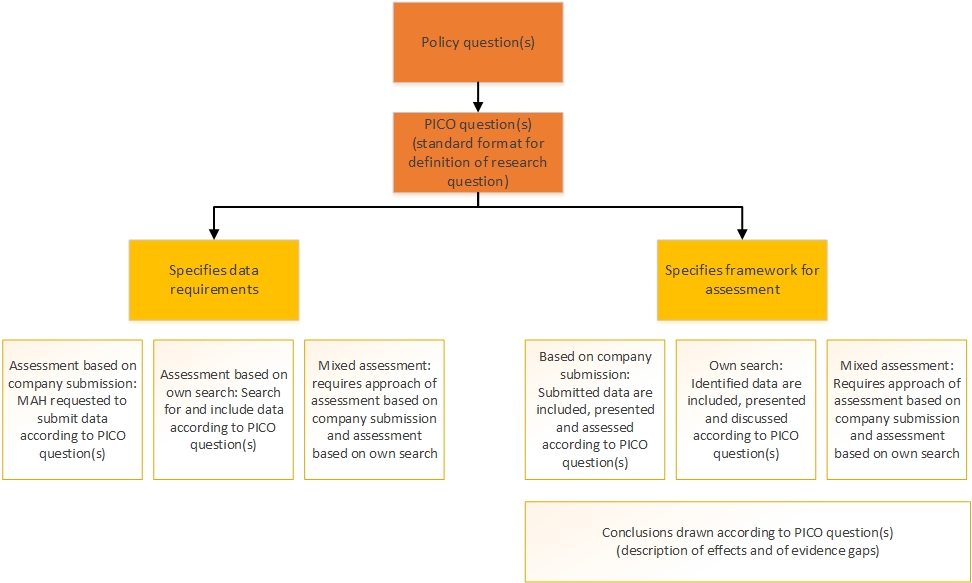PICO FAQ
You can access the PICO Concept Paper from EUnetHTA Joint Action 3 here. Below you can find the PICO FAQ, which is derived from the concept paper.
What is the role of a PICO question for a EUnetHTA assessment?
The starting point for an assessment of a medical intervention is the formulation of a defined research question that should be answered by the assessment. In the context of EUnetHTA, the research questions to be investigated are based on policy questions from the health care systems in which a HTA report should be used. Given the diversity of health care systems in Europe, it is possible that, for a given medical intervention, different policy questions are formulated by different partners.
The assessment of an intervention should not be data-driven, i.e. the research questions should not be deduced from the available studies (either identified via an own information retrieval by the authoring team or submitted by the MAH/manufacturer). Rather, an appropriate translation of the policy question into a research question should be performed in the planning stage of the assessment. This means that the research question (the PICO – Population, Intervention, Comparator(s), Outcomes) is pre-specified for a given assessment.
What is the PICO framework?
The PICO framework provides a standard format for the definition of a research question, e.g. for a comparative assessment of the effectiveness and safety of various treatment options.
Within the PICO framework research questions are defined using (at minimum) the following components:
P (population) | the patients or population(s) in which the intervention under assessment should be used |
I (intervention) | the therapeutic, diagnostic or preventive intervention under assessment (incl. setting) |
| C (comparator) | the alternative intervention(s) against which the intervention under assessment should be compared |
| O (outcomes) | the outcomes of interest (if relevant incl. minimum follow-up time) |
Because of different policy questions from different partners (e.g. due to differences in standard of care) or because of different research questions within the complete approved indication of a specific treatment (e.g. due to different lines of therapy), it is possible that more than one PICO is required to define the research questions to be answered in a given assessment. In this document, an individual set of PICO elements which together define a research question is called a PICO question. Thus, within a given assessment there might be the need to elaborate on one or more PICO questions.
In several countries the assessment of the complete approved indication of a new pharmaceutical intervention is required. Therefore, the PICO question(s) should always cover the complete suggested (and finally approved) indication for pharmaceuticals. The situation for other technologies is more complex. Therefore, the question of how broad the indication covered by the PICO needs to be is decided on a case-by-case basis.
How is the PICO used in the assessment?
The translation of the policy question into a research question via a PICO helps to specify the data requirements and the framework for the assessment.
Data requirements
Currently, EUnetHTA has several options for an assessment with regard to information retrieval:
- To perform an assessment based on an evidence submission by a (prospective) marketing authorisation holder (pMAH)/manufacturer.
- To perform an assessment based on an own information retrieval by the EUnetHTA authoring team.
- To perform an assessment based on a mixed information retrieval, i.e. based on an evidence submission by a (prospective) marketing authorisation holder (pMAH)/manufacturer which is supplemented by evidence from an own information retrieval by the EUnetHTA authoring team.
The PICO questions specify the data requirements for all types of approaches.
Once the PICO questions are defined, they also determine eligibility criteria (for the individual components defined in the PICO questions) for studies or data to be included in the assessment. Inclusion criteria based on the PICO questions may be supplemented by additional criteria such as, for example, study type or duration of study. These additional criteria are outside the scope of this document. Inclusion and exclusion criteria should be reported in the methods section of the project plan.
If the available studies as such do not meet the requirements of the PICO questions, there are various methodological options to approach an assessment of the research question specified by a PICO. In addition to inclusion of complete studies, subsets of data from studies (e.g. subpopulations meeting the population definition from the PICO question) could be relevant for an assessment. If no direct comparisons of the intervention and comparator specified in a PICO question are available, the requirements of the specific PICO might also be approached by appropriate indirect comparisons. All these options stand under the reservation of the use of consolidated EUnetHTA methodology.
For assessments involving evidence submission by (p)MAHs/manufacturers, the PICO questions and thus the resulting data requirements are communicated to the (p)MAH/manufacturer to enable a data submission that meets the requirements of the assessment.
Framework for the assessment
In the assessment the data are included, presented and assessed according to the PICO question(s).
In case of assessments based on an evidence submission by a company, the submitted evidence is checked to ensure it meets the requirements of the PICO question(s). If the assessment includes evidence based on an own information retrieval by the EUnetHTA authoring team, the evidence identified by the search is checked to ensure it meets the requirements of the PICO question(s). This also includes an evaluation of whether any deviations from the PICO question(s) in the available evidence (e.g. in the included patient population) means that a study or data set still allow for any conclusions with regard to the PICO question(s), or whether the data cannot be used in the assessment of the PICO question(s) (and the resulting gaps are described in the evidence gaps table).
The evidence relevant with regard to a given PICO question is presented and assessed for an answer to the research question reflected by the PICO. The conclusions from the assessment are drawn according to the PICO question(s). This includes both the description of effects and evidence gaps.
The following figure presents an overview of the role of a PICO for EUnetHTA assessments.

Figure 1 – Role of the PICO for EUnetHTA assessments
Can study/studies be presented and assessed, even if they do not meet the PICO question(s)?
In addition to the assessment according to the PICO questions(s) defined in the planning stage of the assessment, it might be an option to provide an assessment of the available studies or of certain studies (according to their originally planned methods), even if they do not meet the PICO questions(s), if this is needed by EUnetHTA partners. Examples could be studies in wider populations than defined by the PICO question(s), or studies with comparators which have not been included in the PICO question(s). This approach should also be decided in the planning stage of the assessment. If additional studies are presented and discussed in the assessment report, it should become clear from the report that this evidence is not addressing the PICO question(s).
Does EUnetHTA have a standard process to develop the PICO question(s)?
For pharmaceutical Joint Assessments, a PICO survey is a standard process step. The Authoring Team drafts the PICO for the survey and all organisations participating in EUnetHTA are invited to respond to the survey by critiquing the PICO. They can give alternative comparators and outcomes. All results will be shared with the Authoring Team. By means of the PICO survey, all partners have the opportunity to share their national needs. The aim of such PICO survey is to support the Authoring Team in developing PICO questions that are relevant for as many EUnetHTA partners as possible. This is with relevant meaning that the included PICO question(s) cover as many partners’ individual PICO question(s) as possible in order to result in as little extra local assessment work as possible. However, at the same time it should not interfere with the national decision-making process (i.e. it should not rank outcomes because the relevance of outcomes will be determined in the national appraisal processes).
For Other Technologies, the use of a PICO survey will be piloted and based on experiences from the pilot, and recommendations about its inclusion into the process will be made. Currently, instead of a PICO survey among all EUnetHTA partners, the individual Assessment team members’ input to the PICO(s) is used to create the final PICO(s) of the assessment, hence representing a subset of national needs within WP4 OT partners.

